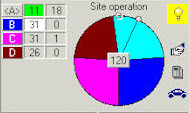In the world of Adaptive Engineering for road traffic management Cycle Time is king and is divided up into Splits - that is, the proportion of time a given "Phase" is displayed to the road users in any given approach to an intersection.
The accepted common convention is to label the phases or splits of a cycle using a single letter starting with the letter "A". So if an intersection's Cycle is split into 4 phases, they would be labelled "A", "B", "C" and "D" respectively, a sample of which is shown:

An example might be:
- A Phase = main north/south movement (road and pedestrians)
- B Phase = main north movement with a left turn that stops the south movement
- C Phase = East/West movement. (road and pedestrians)
- D Phase = East/West movement with a right turn that stops the west movement
An example of the Phases or Stages an intersection goes through is shown below:

The Cycle Time is measured in seconds and is the total time of the phase times:
CYCLE TIME = A + B + C + D
In an adaptive system that includes the SCATS® System and ATSC4 controllers, this cycle time is never fixed, it is VARIABLE, and changes according to the algorithms that SCATS® uses, this is how SCATS® becomes FULLY ADAPTIVE.
For example at T+0 the Cycle Time may be T0 = A+B+D
At T+1 the Cycle Time may be:T1 = A+B+C+D
Each phase will have a certain "minimum" time that must be run, so there are no wild swings in the times experienced by road users, but small adjustments and efficient use of the whole cycle to move the the traffic on the approach with the greatest traffic volumes.
The phases of an intersection, depending on how they are configured, can be optionally introduced, such as the "C" phase, only when a pedestrian "pushes" a button indicating they want to cross the road, otherwise the Traffic Signal Controller does not need to go to a "C" phase. This ability to respond in real time means that the traffic runs as efficiently as it can but respond to demands when they are present such as a vehicle on a left turn loop or a pedestrian wanting to cross the road.
What are Splits and Offsets?
Back to Adaptive Engineering